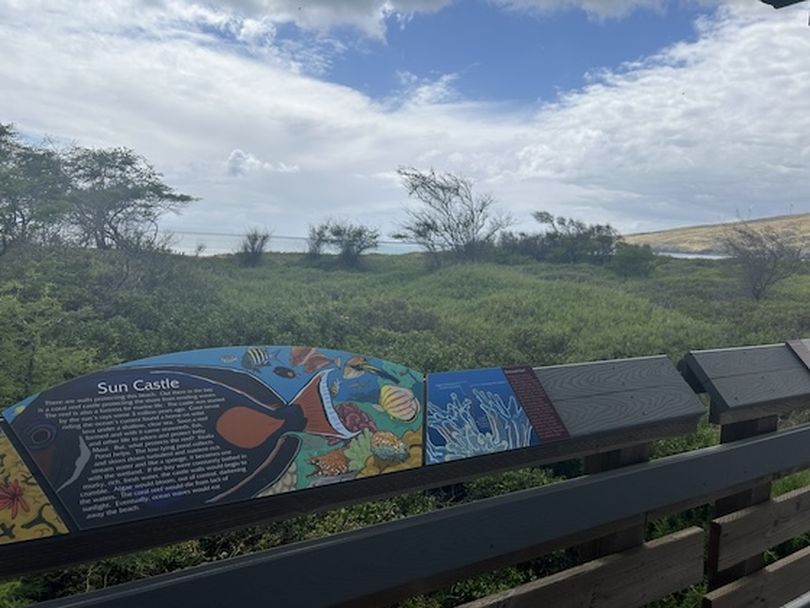Last and longing looks at America’s paradise

Of all the theories about how the Maui town of Lahaina got its name, I like the one about the angry bald-headed Hawaiian chief.
Legend has it that the chief, traveling along the northwest coast of the island without a hat, became annoyed at the blazing sun. “He keu hoi keia o ka la haina!" he supposedly cried out.
Which was his way of cursing the sun, those final two words, “la haina,” loosely translated as “merciless sun.”
It seems ironic that, on Aug. 8 of last year, it was another kind of merciless fire that destroyed roughly 80 percent of the town, killing at least 101 people. You can read about it here.
During our recent week-long stay on Maui, which I’ve been recounting in the last few posts, my wife and I knew we’d have to at least try to see what remained of the scenic little village. It had been, after all, our first stop during our honeymoon in 1995.
But as we feared, the roads leading off Hawaii Route 30 into Lahaina were blocked to all but residents. We were shunted around the town to a bypass that trailed up the coast toward Kaanapali and beyond. The traffic on that stretch of road was horrendous, so we did a quick turn-around.
The only thing we could notice as we drove past both ways was that the highlands above the town showed no sign of a recent fire. The grassy slopes were mostly green.
It was only a few hours later, when we stopped at the Keālia Pond National Wildlife Refuge, that we were given an explanation. The woman behind the desk, a former Mainlander who said she’d lived on Maui for the past 46 years, said that until relatively recently the area had still looked scorched.
“For the last month we’ve had a lot of rain,” she said. “So everything has grown back.”
Nature tends to do that. Meanwhile, the town itself slowly attempts to rebuild. You can help with that effort by donating here.
Famished after our aborted road trip, we stopped at a local spot for some lunch. Set in a Kihei strip mall, and the kind of small place that serves dishes in Styrofoam packages, Da Kitchen specializes in Hawaiian food. So we ordered what was billed as a mixed plate, which featured a combination of fried fish, pulled pork, spring rolls, fresh veggies and rice.
It was just what we needed. And I’ll add that the young woman who waited on us was a nice as anyone we’d met so far (much more friendly than the brusque attitudes showed us by the folks at the Pukalani Country Club).
Out hunger appeased, we headed to the spot that I mentioned above: the Keālia Pond National Wildlife Refuge. Established in 1992, the refuge is the largest lowland wetland in Maui (56 square miles in all) and was designed as a way to protect a pair of endangered Hawaiian waterbird species: the Hawaiian coot (‘alae ke‘oke‘o) and the Hawaiian stilt (ae‘o).
After hearing a lecture about the refuge, the birds that it protects and the woman’s reaction to the Lahaina fire – “How heartbreaking,” she said – we headed toward a nearby attraction that we visited once before: the Keālia Coastal Boardwalk.
Not quite a mile in length, the boardwalk gives visitors both access to the adjacent beach along with lessons in the area’s natural history. Example: “Humans have been around for about 3 million years. Honu ‘ea (hawksbill turtles) have been swimming the oceans for 100 times that.”
While looking far more weathered than when we first walked it in 2016, the boardwalk is still a nice respite from the more crowded parts of Maui.
Also relaxing was the stop we made enroute to our rented condo. We found easy street parking at Kamaole Beach, which gave us the opportunity to sit on the sand, people-watch and simply enjoy the thing I most miss about living in Spokane: proximity to the ocean.
That night, our last in Maui, we splurged and ate dinner at Spago, the lah-dee-dah Wolfgang Puck restaurant that is set in the Four Season in Wailea – the place, by the way, where they filmed the first season of the Hulu series “The White Lotus.” And to be honest, what I ordered there was no better than what I had eaten at Da Kitchen – at less than a quarter the price. But … the atmosphere was what you expect from a world-class eatery, and as an added treat we were able to witness a glorious sunset from the restaurant’s terrace – one of the few that we managed to catch our whole vacation.
The next day, looking to fill the hours before we caught our red-eye home, we started out by eating breakfast at the sidewalk Kihei Café. Then we took a leisurely drive south and stopped at a place called Makena Landing, which overlooks a small bay sporting a beach that looks perfect both for bathing and snorkeling.
As I stood there, a guy relaxing in a beach chair responded to my question by politely correcting my pronunciation of Makena (not Mah-KAY-nah as I’d thought but the more Irish-sounding Muh-KEN-uh). Then he pointed to our right.
“Over there you can usually see some sleeping turtles,” he said. So over we walked and, yes, there they were, a pair of them. I can’t say whether they were Hawksbill turtles (again Honu ‘ea), but they did look tired enough to have been swimming for many millions of years.
Catching a bit of nature felt like a fitting way to say aloha to our third, and most enjoyable Maui visit. Maybe, though, next time we’ll give Kauai a second chance.
Going from the Valley Isle to the Garden Isle seems like a natural enough transition.
